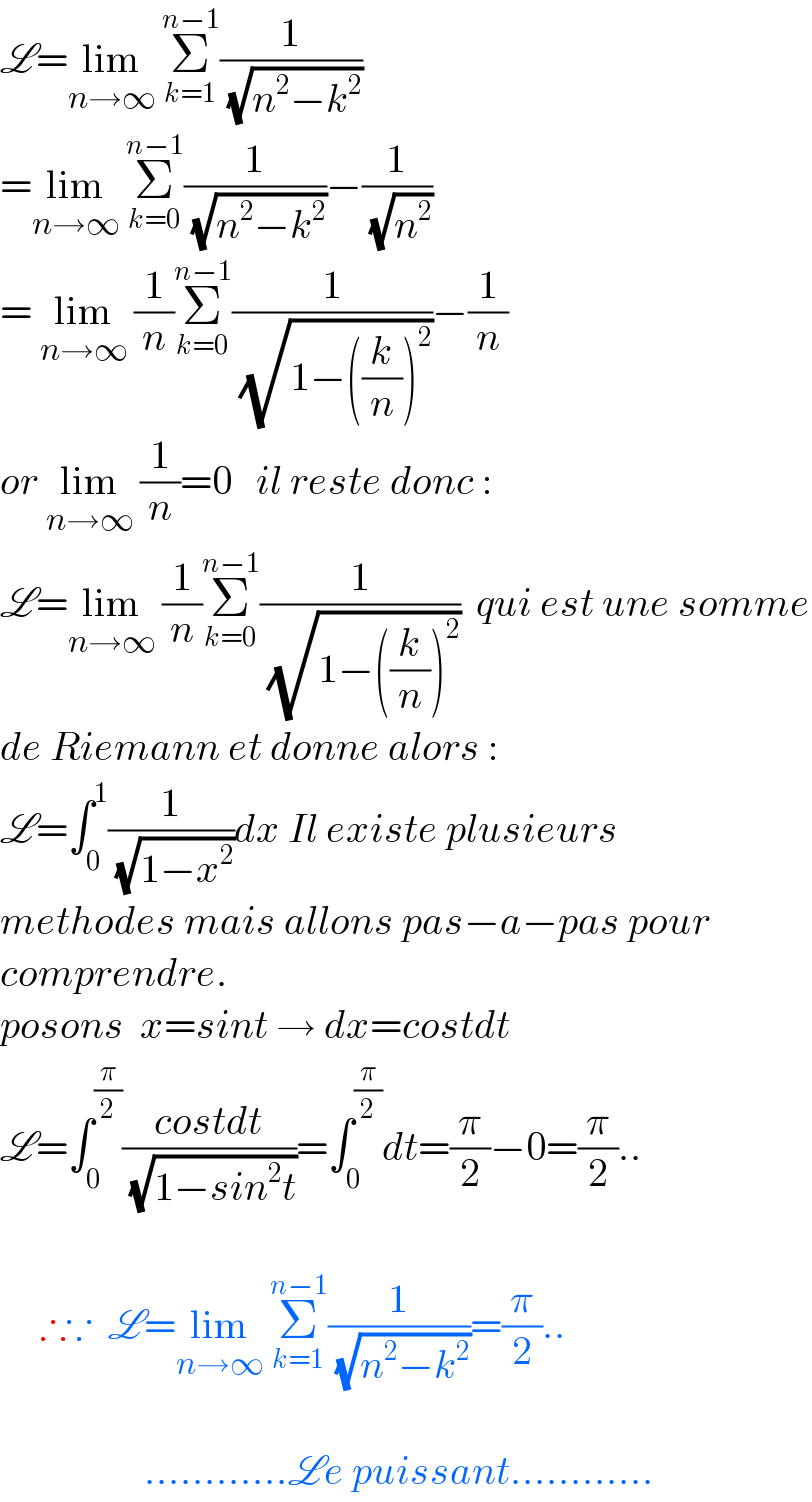Question Number 155806 by SANOGO last updated on 05/Oct/21

Answered by puissant last updated on 05/Oct/21

$$\mathscr{L}=\underset{{n}\rightarrow\infty} {\mathrm{lim}}\:\underset{{k}=\mathrm{1}} {\overset{{n}−\mathrm{1}} {\sum}}\frac{\mathrm{1}}{\:\sqrt{{n}^{\mathrm{2}} −{k}^{\mathrm{2}} }}\: \\ $$$$=\underset{{n}\rightarrow\infty} {\mathrm{lim}}\:\underset{{k}=\mathrm{0}} {\overset{{n}−\mathrm{1}} {\sum}}\frac{\mathrm{1}}{\:\sqrt{{n}^{\mathrm{2}} −{k}^{\mathrm{2}} }}−\frac{\mathrm{1}}{\:\sqrt{{n}^{\mathrm{2}} }} \\ $$$$=\:\underset{{n}\rightarrow\infty} {\mathrm{lim}}\:\frac{\mathrm{1}}{{n}}\underset{{k}=\mathrm{0}} {\overset{{n}−\mathrm{1}} {\sum}}\frac{\mathrm{1}}{\:\sqrt{\mathrm{1}−\left(\frac{{k}}{{n}}\right)^{\mathrm{2}} }}−\frac{\mathrm{1}}{{n}} \\ $$$${or}\:\underset{{n}\rightarrow\infty} {\mathrm{lim}}\:\frac{\mathrm{1}}{{n}}=\mathrm{0}\:\:\:{il}\:{reste}\:{donc}\:: \\ $$$$\mathscr{L}=\underset{{n}\rightarrow\infty} {\mathrm{lim}}\:\frac{\mathrm{1}}{{n}}\underset{{k}=\mathrm{0}} {\overset{{n}−\mathrm{1}} {\sum}}\frac{\mathrm{1}}{\:\sqrt{\mathrm{1}−\left(\frac{{k}}{{n}}\right)^{\mathrm{2}} }}\:\:{qui}\:{est}\:{une}\:{somme} \\ $$$${de}\:{Riemann}\:{et}\:{donne}\:{alors}\:: \\ $$$$\mathscr{L}=\int_{\mathrm{0}} ^{\mathrm{1}} \frac{\mathrm{1}}{\:\sqrt{\mathrm{1}−{x}^{\mathrm{2}} }}{dx}\:{Il}\:{existe}\:{plusieurs}\: \\ $$$${methodes}\:{mais}\:{allons}\:{pas}−{a}−{pas}\:{pour}\: \\ $$$${comprendre}. \\ $$$${posons}\:\:{x}={sint}\:\rightarrow\:{dx}={costdt} \\ $$$$\mathscr{L}=\int_{\mathrm{0}} ^{\frac{\pi}{\mathrm{2}}} \frac{{costdt}}{\:\sqrt{\mathrm{1}−{sin}^{\mathrm{2}} {t}}}=\int_{\mathrm{0}} ^{\frac{\pi}{\mathrm{2}}} {dt}=\frac{\pi}{\mathrm{2}}−\mathrm{0}=\frac{\pi}{\mathrm{2}}.. \\ $$$$ \\ $$$$\:\:\:\:\:\therefore\because\:\:\mathscr{L}=\underset{{n}\rightarrow\infty} {\mathrm{lim}}\:\underset{{k}=\mathrm{1}} {\overset{{n}−\mathrm{1}} {\sum}}\frac{\mathrm{1}}{\:\sqrt{{n}^{\mathrm{2}} −{k}^{\mathrm{2}} }}=\frac{\pi}{\mathrm{2}}.. \\ $$$$ \\ $$$$\:\:\:\:\:\:\:\:\:\:\:\:\:\:\:\:\:\:…………\mathscr{L}{e}\:{puissant}………… \\ $$
Commented by SANOGO last updated on 05/Oct/21

$${merci}\:{bien} \\ $$
